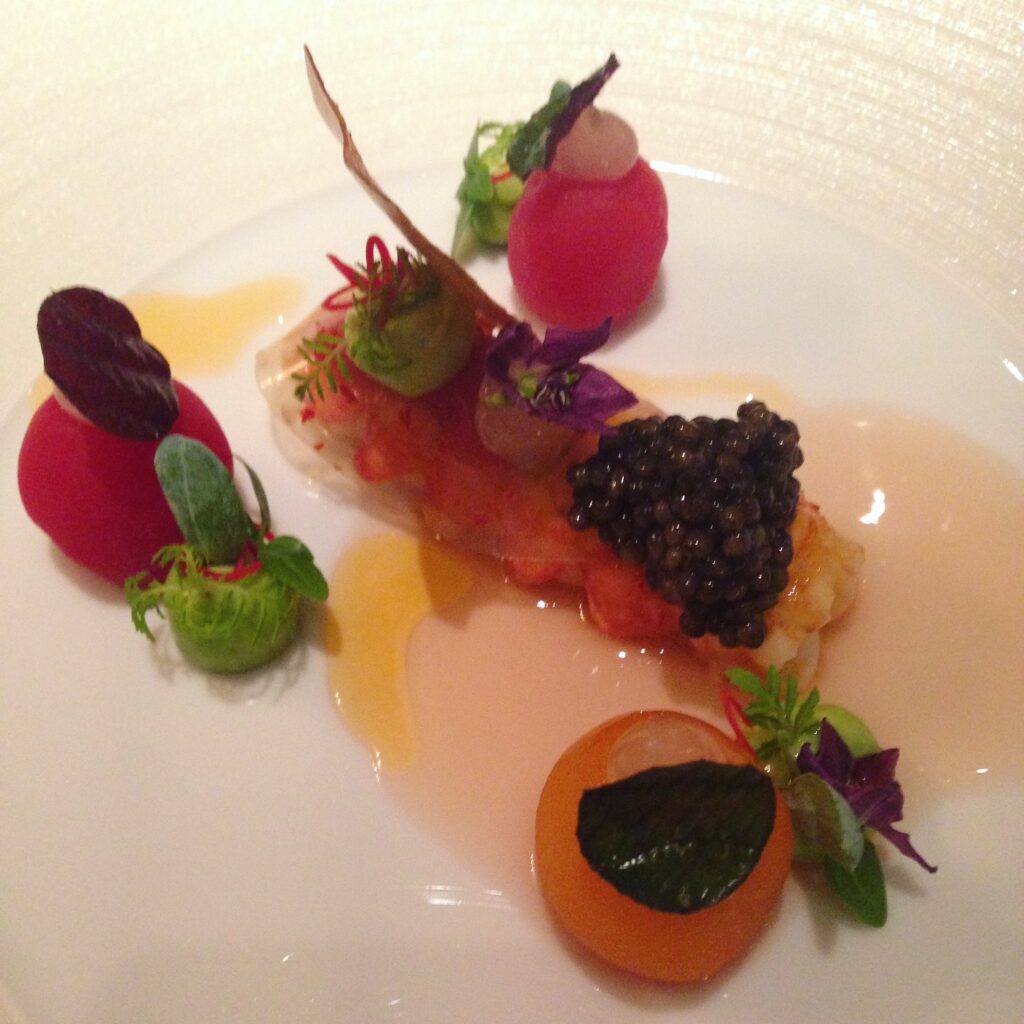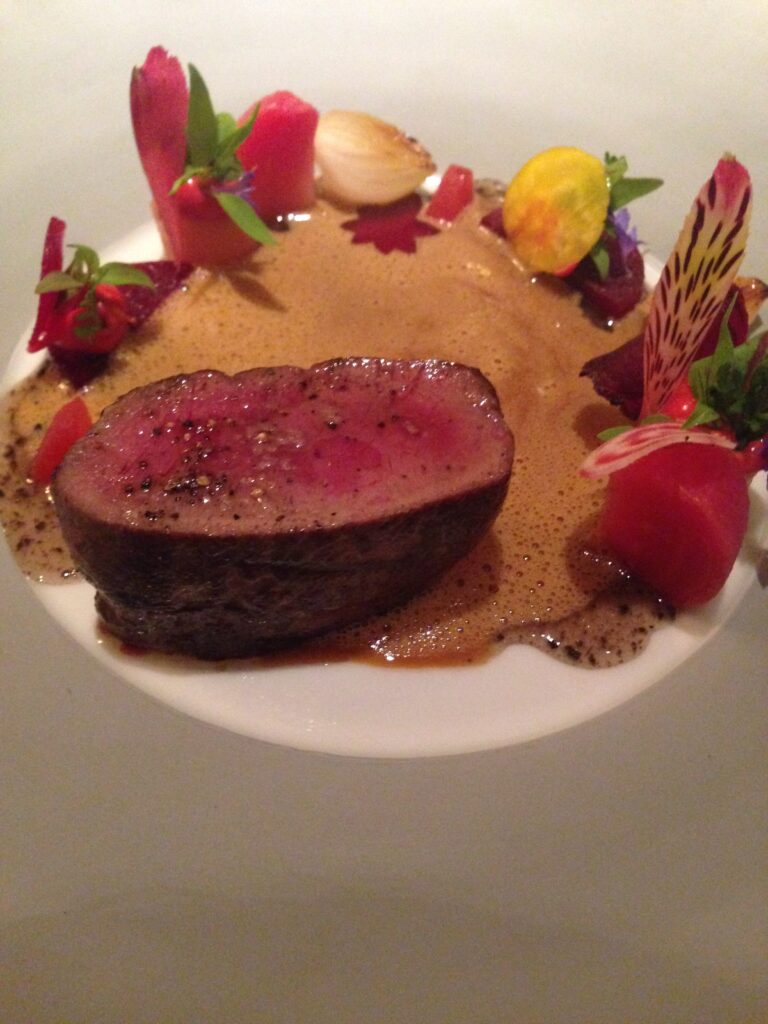The high-end cuisine in most of the German speaking parts of Europe very often lacks a unique flair and identity. This is a bold statement to make and a harsh analysis, too. Having lived in the German speaking hemisphere since my birth, I’ve eaten at many gastronomic restaurants, few were able to deliver excellence. Excellence in dining is, from my very personal point of view, the sourcing of reference quality ingredients, the mastery of technique as a means to let those ingredients shine, a balanced flavor profile and the confidence to free a plate from unnecessary components.
The approach of displaying as many techniques as possible on a plate, showing German perfectionism by putting the technical capacity in the center of the dining experience, results in plates that I find more often confuse and delineated than spot on and precise. Blood sorrel on every second dish is repetitive, gels do often perfectly suit flavor-wise, but it’s not quite creative for a cuisine that wants to be creative to put a gel on every single plate, is it? The search for identity is hard, but can a technique-centered approach be the answer, when the most successful cuisines emphasize some kind of terroir? Can technical precision be the trademark of a whole branch of cuisine in a world where high-end kitchens of such different schools as L’Ambroisie and Frantzén look for the perfect cuisson of a langoustine?
Admittedly, the willingness to reduce the number of ingredients and create more focused dishes has increased, caused, however, not by the intention to create an own identity but furthermore inspired by what is happening in Scandinavia. Even the Nordic inspiration didn’t help to eradicate the unnecessary blood sorrel decoration and inflationary gels, unfortunately.
This, I know, sounds all very negative, but I’ve had great meals in ‘German-style’ high-end restaurants, meals where the multi-component approach worked, because the flavor-profiles were stunning, the balance incredible, the sauces textbook. This cuisine isn’t a mediocre approach per se; when executed properly you can have world class meals. The proper execution does, and this is where this kind of cuisine tires me the most, play an immensely integral role the more components you use. Balance is much more difficult to achieve the more components you use. The chance to distract from the main ingredient is much higher the more components you use.

A recent meal at Werneckhof by Geisel in Munich, where the superbly talented Tohru Nakamura, who trained at the three-starred restaurants Oud Sluis, Ishikawa in Tokyo and Vendôme, is in charge of the kitchen, showed great potential. Nakamura currently holds two stars, I think he’d be a candidate for Michelin’s highest accolades if only he would excise some of the ‘German symptoms’ described above. Here are some notes that underline my thesis:

After a handful of enjoyable amuses-bouches a very high-quality Brittany langoustine, cooked perfectly, was served with tomatoes of mind-blowing quality, caviar, a shiso vinaigrette, a bergamotte-gel, a green cream (avocado?), some decorative herbs, an iodized jelly and a cracker. Firstly, I think the dish would have been better off without the caviar as the caviar didn’t add too much and felt out of place. Secondly, the textural contrasts from the cracker did nothing but distract from the beautifully sweet langoustine. Thirdly, the herbs didn’t add to much either. This dish confirmed many of my problems with this technique-focused approach. The tomatoes were superb, the combination with the langoustine light, elegant, estival. The tomatoes’ acidity emphasized the langoustine’s inherent nutty sweetness, the green cream and the bergamotte-gel added a welcome ‘smoothness’ and opulence, as well as a welcome additional flavor dimension. The shiso vinaigrette was a nice bridge holding everything together yet was never at the forefront. Great potential, as I said above.
Another dish had pike-perch as its main component. I live in a region, where there’s plenty of pike-perch. I’ve eaten pike-perch many, many times. This was a superb product, again cooked perfectly. The fish had a meaty texture, bite and a cœur that was medium-rare. In a nutshell, this was a top-notch product cooked so that it had character. The two sauces accompanying the pike-perch were a beautiful savory vinaigrette that added a bright freshness, an acidic herbaceousness and a light velvety soy bean beurre blanc on dashi base. Considering Nakamura’s background and his style this didn’t feel forced or out of place here, but I couldn’t help wondering whether a stronger base with more punch wouldn’t have better stressed the subtly roasted flavors and thwarted the vinaigrette. Again, there were the obligatory gel and micro-leaves, among others fenugreek. There were also two dots of a (soy bean?) purée, a green purée, some tofu and a torched piece of leek. The tofu was a nice idea and paired well with the perch. But the leek was unnecessary and why the repetitive purées and gels? The vinaigrette and the beurre blanc had a precise and welcome level of acidity, there was no need for more. And I say this as an acidity junkie!

The most problematic dish followed – a piece of caramelized veal sweetbread sitting on koshihikari rice, squash, hassaku and Nikka whiskey. I had high expectations. This combination sounded like a lot I like. Sweetbread, Japanese agrumes, a reduced sauce with whiskey, rice – perhaps a bit creamy. Who wouldn’t like that? Unfortunately, the dish was nothing like that. The sweetbread was the only protein not cooked perfectly this evening. Compared against the top sweetbread dishes I have tasted, I felt it was overcooked and had an insufficiently crispy surface. The rice was boring and added nothing. Squash purée and gels were fine and would have worked with dish I imagined, but the light vinaigrette infused with Nikka whiskey didn’t have the power nor the complexity to hold this together.
What followed was an excellent piece of deer with textures of beets. A sauce riche was how I’d think of marriage between French and Japanese technique. Very solid, flawless cooking.


The desserts showed the best side of New German Cooking. An immensely complex dish of citrus fruits was balanced perfectly. Bitterness, acidity, sweetness. God this was harmonious, there were bitter edges of grapefruit, exotic velvetiness of coconut. Citrus pearls, citrus jelly, meringue, a sphere filled with a very French crème. The textural interplay was great fun. I enjoyed this a lot. The same could be said about the second dessert, Williams pear and a sticky toffee pudding.



Nakamura is a very talented guy, his skills are striking, he sources very good products. The Japanese influence doesn’t feel forced in his case, it’s honest. Nakamura has already created a personal, if not singular, style. If only he were to remove the multi-component burden…





